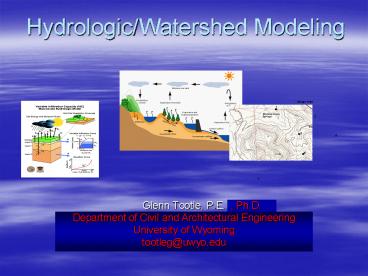Hydrologic/Watershed Modeling - PowerPoint PPT Presentation
1 / 24
Title:
Hydrologic/Watershed Modeling
Description:
... 00 23682.00 23682.00 23682.00 23712.00 23712.00 23712.00 23743.00 23743.00 23743.00 23774.00 23774.00 23774.00 23802.00 23802.00 23802.00 23833.00 23833.00 ... – PowerPoint PPT presentation
Number of Views:827
Avg rating:3.0/5.0
Title: Hydrologic/Watershed Modeling
1
Hydrologic/Watershed Modeling
- Glenn Tootle, P.E.
- Department of Civil and Environmental Engineering
- University of Nevada, Las Vegas
- tootleg_at_unlv.nevada.edu
, Ph.D.
Department of Civil and Architectural
Engineering University of Wyoming tootleg_at_uwyo.edu
2
Questions?
- Who has used / developed a hydrologic model?
- What model(s) did you use?
- Examples
3
Conceptual Model of Watershed Modeling
- Typical Input
- Topography
- Soil Characteristics
- Land cover
- Land use
- Meteorological data
- Typical Output
- Streamflow
- Subsurface Flow
- Depth to water table
4
Steps to Hydrologic Modeling
- Delineate watershed
- Obtain hydrologic and geographic data
- Select modeling approach
- Calibrate/Verify model
- Use model for assessment/prediction/design
5
What is a Watershed?
- Area that topographically contributes to the
drainage to a point of interest
Natural Watershed
- Points of Interest
- Road crossing
- Stream gage
- Reservoir inlet
- Wastewater treatment plant
- Location of stream restoration
6
Urban Watershed
7
USGS Quad Map
8
Digital Elevation Model (DEM)
- Digital file that stores the elevation of the
land surface a specified grid cell size (e.g., 30
meters)
9
Geographic Data
- Land cover
- Land use
10
Geographic Data
- Soil type/classification
11
Hydrologic Data
- Meteorological Data
- Temperature
- Precipitation
- Wind speed
- Humidity
- Extrapolation of point measurements
- Theissen Polygons
- Inverse distance weighting
12
Hydrologic Data
Streamflow
- Hydrologic Data
- Streamflow
- Peak discharge
- Daily flow volume
- Annual flow volume
- Soil moisture
- Groundwater level
13
Modeling Approaches (examples)
TIME SCALE TIME SCALE
Event-based (minute to day) Continuous Simulation (days years)
Empirical Regression equs Transfer Functions Simple models Rational Method SCS Unit Hydrograph Simple Model
Physically-based Based on physical processes Complicated Many parameters KINEROS Stanford Watershed Model TOPMODEL SWAT VIC-3L TOPMODEL
14
Basis for Many Hydrologic Models
- Hydrologic Budget (In Out ?Storage)
Transpiration (T)
Streamflow (Q)
Evaporation (E)
Groundwater out (GWout)
Reservoir
Precipitation (P)
Groundwater in (GWin)
Infiltration (I)
Watershed
(P GWin) (E T I GWout Q)
?Storagereservoir
15
Which Model Should be Used?
- It Depends on
- What time scale are you working at?
- What hydrologic quantity are you trying to
obtain? - What data do you have for your watershed?
- How fast of a computer do you have?
16
Spatial Scaling of Models
Semi-Distributed Parameters assigned to each grid
cell, but cells with same parameters are grouped
Fully-Distributed Parameters assigned to each
grid cell
Lumped Parameters assigned to each subbasin
A3
A1
A2
17
Stanford Watershed Model(HSPF)
- Physically-based and continuous simulation
18
Variable Infiltration Capacity (VIC-3L)
- Continuous simulation and physically-based
- Macroscale hydrologic model that solves full
water and energy balances
19
VIC-3L Example
20
Calibrating a Model
- Typically the model is calibrated against
observed streamflow data - Depending on the model complexity, parameters are
adjusted until observed streamflow equals model
streamflow - Which observed value to use
- Qpeak
- Qvolume
- tpeak
Qpeak
Q
tpeak
Qvolume
t
21
Sensitive Parameters
- Precipitation
- Soil parameters
- Hydraulic conductivity
- Soil water holding capacity
- Evaporation (for continuous simulation)
- Flow routing parameters (for event-based)
22
Uncertainties
- Precipitation
- Extrapolation of point to other areas
- Temporal resolution of data
- Soils information
- Surveys are based on site visits and then
extrapolated - Routing parameters
- Usually assigned based on empirical studies
23
Use of Models
- Assessment
- What happens if land use/land cover is changed?
- Prediction
- Flood forecasting
- Design
- How much flow will occur in a 100 year storm?
24
QUESTIONS

